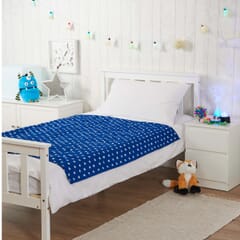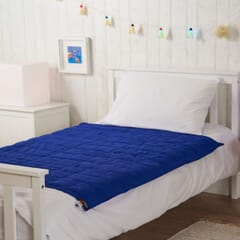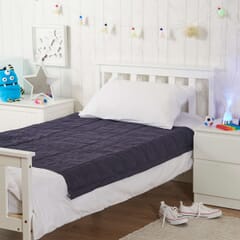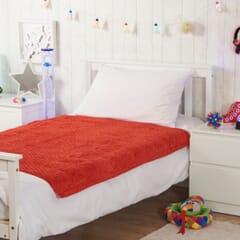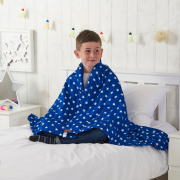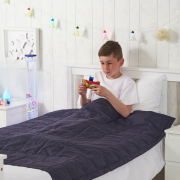Get exclusive deals you won't find anywhere else straight to your inbox.
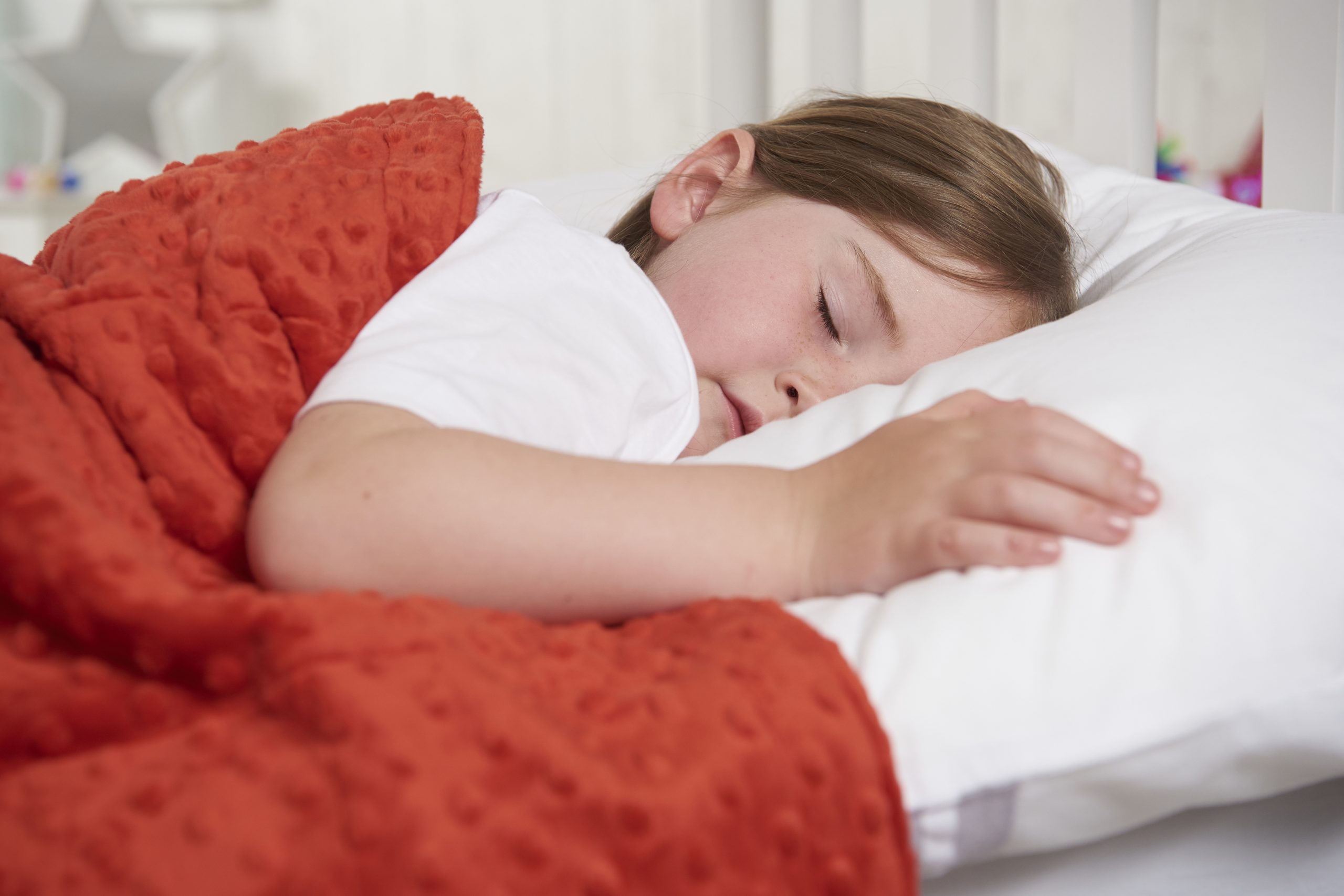
Could a Weighted Blanket Help Your Child Sleep?
What is weighted therapy?
Weighted Therapy is the use of weight to apply deep pressure to the body. The weight and pressure stimulate the proprioceptive sense. This helps those who are “sensory seeking” to relax, focus, and develop a greater awareness of their body.
People often refer to weighted therapy as deep touch pressure, and many use it to support children and adults with an underdeveloped proprioceptive sense.
Benefits of weighted therapy
The benefits of weighted therapy are:
- can have a calming effect, promoting a sense of wellbeing
- improved body awareness
- help to improve focus and concentration
- reduce repetitive sensory-seeking behaviour
- safe and effective
- non-invasive and discreet
Occupational Therapists often include weighted therapy in a ‘sensory diet’ to support individuals with Sensory Integration Disorder
Sleeping
Often children with poor proprioception do not sleep well, particularly if they are sensory-seekers. They may take a long time to go to sleep, and then wake throughout the night. As a parent this can be immensely frustrating, not to mention exhausting.
For some people it is difficult to understand the appeal of weight and deep pressure. The principle is the same as swaddling a new-born baby. The newborn feels comforted and calmed when someone wraps him tightly in a blanket.
Many children seek this type of deep pressure at bedtime by requesting to be wrapped up tightly or asking for extra covers for added weight and pressure. As a child, particularly in the days when we just had sheets and blankets, you may have been ‘tucked in’ tightly when you went to bed. Remember the feeling of comfort and security this application of deep pressure gave? Children with poor proprioception need this feeling all of the time.

What is a weighted blanket
Weighted Blankets are, in simplest terms, blankets filled with weight. They provide sensory feedback to the user through deep pressure. The weight is usually in the form of plastic beads, but can also be sand, steel shot or even corn seed.
Weighted Blankets are typically used to provide sensory comfort for autistic children and adults.They are now widely used for other reasons such as reducing stress and anxiety, PTSD and even panic attacks.
Types of weighted blanket
Weighted blankets are widely available in a range of different materials. The most commonly used materials are fleece, neoprene, cotton, or a polyester-cotton mix.
There are advantages and disadvantages to each. Fleece is a very tactile material, and some children may not like the feeling it provides. Another consideration is that, being quite thick, it may cause overheating if used with other bedclothes. Neoprene is used to manufacture wetsuits, and neoprene blankets tend to be quite inflexible. They can often becoming hot and sweaty if used on a bed. Poly-cotton mix blankets provide excellent comfort and durability and are fully washable. They have the advantage of not providing too much additional insulation, so your child will not overheat, particularly in warm weather.
Blanket weights
Weights used inside a blanket vary between plastic pellets, sand, steel shot and even corn seed. Sterile sand is popular as a filling, but sand blankets are not easily washed. Steel shot is very heavy and offers excellent weight density but once again, washing these blankets can be a problem unless the steel shot is in a waterproof outer such as neoprene.
Blanket weights
Traditionally, people have sewn weights into the actual blanket. Now, however, some blankets use removable weight bags which fit into pockets sewn onto the blanket. You can fit these blankets into a cover to ensure the weights cannot easily be removed. This technique has several advantages over the more traditional blankets;
- It's easy to remove the weights to allow for easy cleaning and washing
- You can tailor the weight of the blanket to the weight of the individual
- It's easy to alter the distribution of the weight. If you have restless leg syndrome, for example, you can concentrate the weight on your legs.
- As your child grows you can easily, and cheaply, add more weight without having to buy a new blanket.
The disadvantage of these blankets is that they do not wrap around the body as well as blankets with the weight sewn in. This is because the weight pockets have a tendency to shift and move around.
Do weighted blankets help you sleep?
The use of a weighted blanket at night time provides a safe and effective solution for many parents and their children.
I have spoken to many parents who have not enjoyed a full night’s sleep for several years, but on introduction of a weighted blanket for their child, have seen dramatic and immediate improvements. Imagine their relief and joy at finally getting a decent night’s sleep!
Many parents now use a weighted blanket as part of their child's bedtime routine. The vast majority of these parents have found weighted blankets to be effective in improving their child's sleep, both in terms of getting to sleep more quickly and easily, and also remaining asleep throughout the night.
A positive difference within the first week!
"I bought a weighted blanket for my three year old son, and I just want to say that it has been magic what that blanket has done for him & us. He had big problems with finding rest during the days and nights. He had trouble in other things too but after sleeping with a Sensory Weighted Blanket there was a positive difference within the first week.
My son is now calmer than before, he talks better, he is more persistent when he is playing, eating and reading compared to what he was like before.
I am extremely satisfied with your weighted blanket!
Anita.R - Denmark

Occupational Therapist Recommendations
Some Occupational Therapists now advise using a weighted blanket under adult supervision at all times. For use at night this effectively means staying with your child until they have gone to sleep and then removing the weighted blanket. This is sensible advice, however it can cause practical difficulties – for example your child may not go off to sleep with you in the room or they may wake in the night and be unable to go back to sleep without their weighted blanket.
For smaller and younger children I would never recommend that you go against the advice of your OT. That said if your child is older, you follow some basic safety guidelines and use some common sense, then leaving a weighted blanket on all night can be OK. We left our son with his weighted blanket all night for many years, but we made sure it was not too heavy (less than 10% of his bodyweight) and that he could remove it himself if he became uncomfortable or too hot. We would also check up on him regularly throughout the night.
If you decide to leave it on all night it is important that you speak to your OT for guidance before you start.
 By Andrew Caws
By Andrew Caws
Managing Director of Sensory Direct & Parent of an Autistic Adult
February 2025



